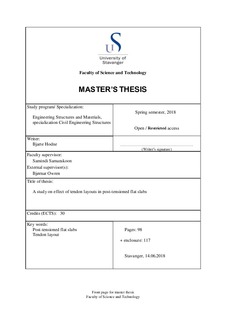| dc.contributor.advisor | Samarakoon, Samindi | |
| dc.contributor.author | Hodne, Bjarte | |
| dc.date.accessioned | 2018-09-12T12:33:16Z | |
| dc.date.available | 2018-09-12T12:33:16Z | |
| dc.date.issued | 2018-06 | |
| dc.identifier.uri | http://hdl.handle.net/11250/2562240 | |
| dc.description | Master's thesis in Structural engineering | nb_NO |
| dc.description.abstract | The use of post-tensioned flat slabs is sufficient when large spans or thin floors are desired. The most used system today is to place unbonded tendons concentrated over the supports in one direction and distribute them across the whole slab in the other direction. This thesis addresses the influence the tendon layout in flat slabs has on the results. Analysis of three different flat slabs with five different tendon layouts in addition to one without any tendons has been done. The tendon layouts vary in the number of tendons that are distributed across the whole slab, the number of tendons that are concentrated over supports, and whether they are placed in the longest or shortest span direction. The calculations are made by hand, and by the programs ADAPT-Floor Pro and FEM-Design 17. Results from the programs has also been compared to enlighten differences. The main difference between ADAPT and FEM-Design is that ADAPT uses design sections which makes it sufficient for the design process of prestressed structures. The program is based on averaging the actions on each design section, which has the width of half the span to both sides of the columns. The feature of modelling unbonded tendons in FEM-Design was new in version 17 released in January 2018. The feature cannot be used for design but are for analysis purpose only. FEM-Design does not use design sections, and some of the results are hence not directly comparable with ADAPT and hand calculations. Results from the analysis shows that a higher portion of tendons that are concentrated instead of distributed, stresses caused by other structural loads is counteracted best. The tensile stresses at columns is most likely to cause cracking of the concrete, and with 100% of the tendons concentrated, the total service stresses here will be the lowest. The layout with all tendons concentrated also has the best results in terms of deflections. This is because the distributed tendons will for small areas cause downward forces in spans, while these downward forces of the concentrated tendons will be directly over the supports. A tendon layout with no distributed tendons may nevertheless not be the most sufficient one because the slab between the supports, where no tendons are placed, may not have enough bending moment capacity. This tendon layout will hence require extra reinforcement in spans to be a sufficient design. The layout where the tendons are distributed and concentrated in both directions does fit the bending moment distribution the best, but the amount of weaving of tendons in spans will increase the construction time, and hence make it uneconomical. | nb_NO |
| dc.language.iso | eng | nb_NO |
| dc.publisher | University of Stavanger, Norway | nb_NO |
| dc.relation.ispartofseries | Masteroppgave/UIS-TN-IMBM/2018; | |
| dc.subject | materialteknologi | nb_NO |
| dc.subject | byggkonstruksjon | nb_NO |
| dc.subject | post-tensioned flat slabs | nb_NO |
| dc.subject | tendon layout | nb_NO |
| dc.title | A study on effect of tendon layouts in post-tensioned flat slabs | nb_NO |
| dc.type | Master thesis | nb_NO |
| dc.subject.nsi | VDP::Teknologi: 500::Bygningsfag: 530::Konstruksjonsteknologi: 533 | nb_NO |
